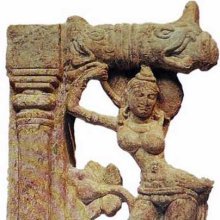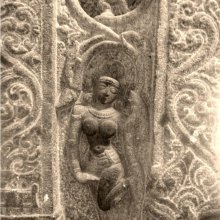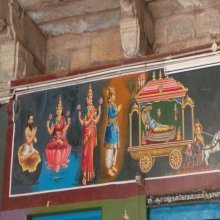Vriksha, Vṛkṣa, Vṛkṣā: 29 definitions
Introduction:
Vriksha means something in Buddhism, Pali, Hinduism, Sanskrit, Jainism, Prakrit, Marathi, Hindi. If you want to know the exact meaning, history, etymology or English translation of this term then check out the descriptions on this page. Add your comment or reference to a book if you want to contribute to this summary article.
The Sanskrit terms Vṛkṣa and Vṛkṣā can be transliterated into English as Vrksa or Vriksha, using the IAST transliteration scheme (?).
Alternative spellings of this word include Vraksh.
Images (photo gallery)
(+6 more images available)
In Hinduism
Ayurveda (science of life)
Nighantu (Synonyms and Characteristics of Drugs and technical terms)
Source: Wisdom Library: Raj Nighantu1) Vṛkṣa (वृक्ष) or Vṛkṣavarga is another name for Prabhadrādi: the ninth chapter of the 13th-century Raj Nighantu or Rājanighaṇṭu (an Ayurvedic encyclopedia). The Rāja-nighaṇṭu is a medical lexicon ascribed originally known as the Abhidhānacuṇāmaṇi. It mentions the names of 1483 medicinal drugs (auṣadhi) and substances (dravya) excluding synonyms, grouped into twenty-two chapters [viz., Vṛkṣa-varga].
2) Vṛkṣa (वृक्ष) refers to a “tree”, as mentioned in a list of twenty-five synonyms in the second chapter (dharaṇyādi-varga) of the 13th-century Raj Nighantu or Rājanighaṇṭu (an Ayurvedic encyclopedia). The Dharaṇyādi-varga covers the lands, soil, mountains, jungles and vegetation’s relations between trees [viz., Vṛkṣa] and plants and substances, with their various kinds.
Unclassified Ayurveda definitions
Source: Wisdom Library: Āyurveda and botanyVṛkṣa (वृक्ष, “tree”).—One the classifications of plants according to their stature. Vṛkṣas are plants that bear flowers and fruits and have trunks and branches such as Kovīdara (Bauhinia). The term is used throughout Ayurvedic literature such as the Suśruta-saṃhitā and the Caraka-saṃhitā.
Vṛkṣa is listed as a classification for plants in the following sources:
The Manusmṛti 1.46-48 by Manu (also known as the Manusaṃhitā and Mānavadharmaśāstra).
The Suśrutasaṃhitā (Sūtrasthāna I.23) by Suśruta.
The Praśastapādabhāṣya by Praśastapāda and its two commentaries Nyāyakaṇḍalī and Kiraṇāvalī.
Vṛkṣa (वृक्ष):—[vṛkṣaḥ] Tree

Āyurveda (आयुर्वेद, ayurveda) is a branch of Indian science dealing with medicine, herbalism, taxology, anatomy, surgery, alchemy and related topics. Traditional practice of Āyurveda in ancient India dates back to at least the first millenium BC. Literature is commonly written in Sanskrit using various poetic metres.
Purana and Itihasa (epic history)
Source: archive.org: Puranic EncyclopediaVṛkṣa (वृक्ष).—(trees) It is stated in Vālmīki Rāmāyaṇa, Araṇya Kāṇḍa, Sarga 14, Stanza 29, as follows about the origin of Vṛkṣas (trees).
Prajāpati Kaśyapa married Analā, the daughter of Dakṣa. Trees yielding good fruits were given birth to by Analā.
Source: archive.org: Shiva Purana - English TranslationVṛkṣa (वृक्ष) refers to a “tree”, according to the Śivapurāṇa 2.3.15 (“The penance and reign of Tārakāsura”).—Accordingly, as Brahmā narrated: “Then the demon Tāraka, of great strength and exploit, endowed with a lofty mind, requested permission of his mother for performing penance. [...] A hundred years he performed the penance amidst fires, a hundred years in a topsy-turvy position and a hundred years supported on the ground by the palms of his hands. O sage, a hundred years he remained with his head down and feet up clinging fast to the branch of a tree [i.e., vṛkṣa-śākhā—vṛkṣasya śākhāmālabya] and inhaling the pure smoke of the sacrificial fire. [...]”.
Source: Cologne Digital Sanskrit Dictionaries: The Purana IndexVṛkṣā (वृक्षा).—Sacred as houses for the primitive man and supplied him with honey, fruits and clothing; Gandharvas live in them; these kalpavṛkṣās deteriorated and man who took to caves began to build houses on the model furnished by the trees with the upward, downward and crosswise trees;1 milked the cow-earth; the essence was tender leaves; the vessel was of pālāśa wood and the plakṣa tree acted as the calf.2

The Purana (पुराण, purāṇas) refers to Sanskrit literature preserving ancient India’s vast cultural history, including historical legends, religious ceremonies, various arts and sciences. The eighteen mahapuranas total over 400,000 shlokas (metrical couplets) and date to at least several centuries BCE.
Shaktism (Shakta philosophy)
Source: Google Books: ManthanabhairavatantramVṛkṣa (वृक्ष) refers to a “tree”, according to the Manthānabhairavatantra, a vast sprawling work that belongs to a corpus of Tantric texts concerned with the worship of the goddess Kubjikā.—Accordingly, “Above [Śiva] is the tranquil (energy called) Śivā. [...] If he desires liberation, the one who possesses (this) glory should abide on that plane. [...] And then the (Supreme) State arises and that state is Śāmbhavī, (otherwise called) Śivā. [...] Pulsating there, he should ascend from the foundation of the root (Wheel) as does a monkey (along) a tree (vṛkṣa), from the soles of the feet up to the top of the head. Then comes liberation in the venerable Śrīkrama. Beyond that is the Transmental. [...]”.

Shakta (शाक्त, śākta) or Shaktism (śāktism) represents a tradition of Hinduism where the Goddess (Devi) is revered and worshipped. Shakta literature includes a range of scriptures, including various Agamas and Tantras, although its roots may be traced back to the Vedas.
Jyotisha (astronomy and astrology)
Source: Wisdom Library: Brihat Samhita by VarahamihiraVṛkṣa (वृक्ष) refers to “trees”, according to the Bṛhatsaṃhitā (chapter 17), an encyclopedic Sanskrit work written by Varāhamihira mainly focusing on the science of ancient Indian astronomy astronomy (Jyotiṣa).—Accordingly, “If Mercury [i.e., Bhauma] should suffer defeat in his conjunction with Mars, trees (vṛkṣa), rivers, ascetics, the people of Aśmaka, the people of the north, sacrificial rites and the Dīkṣitas performing them will suffer much”.

Jyotisha (ज्योतिष, jyotiṣa or jyotish) refers to ‘astronomy’ or “Vedic astrology” and represents the fifth of the six Vedangas (additional sciences to be studied along with the Vedas). Jyotisha concerns itself with the study and prediction of the movements of celestial bodies, in order to calculate the auspicious time for rituals and ceremonies.
Sports, Arts and Entertainment (wordly enjoyments)
Source: archive.org: Syainika Sastra of Rudradeva with English Translation (art)Vṛkṣa (वृक्ष) refers to “trees” (as opposed to Avṛkṣa—‘absence of trees’), according to the Śyainika-śāstra: a Sanskrit treatise dealing with the divisions and benefits of Hunting and Hawking, written by Rājā Rudradeva (or Candradeva) in possibly the 13th century.—Accordingly, “Hunting on horseback (āśvina) represents one of the eight subdivisions of Hunting (mṛgayā). [...] Hunting on horseback leads to intense delight. In this kind, running animals are killed with arrows and with the help of horses. The ground should be without mud and without stones, without trees (avṛkṣa), and without pits [avṛkṣakardamagrāvā nīrandhrā], the appropriate time being from the middle of the cold season to the middle of Jyaiṣṭha. [...]”.

This section covers the skills and profiencies of the Kalas (“performing arts”) and Shastras (“sciences”) involving ancient Indian traditions of sports, games, arts, entertainment, love-making and other means of wordly enjoyments. Traditionally these topics were dealt with in Sanskrit treatises explaing the philosophy and the justification of enjoying the pleasures of the senses.
General definition (in Hinduism)
Source: archive.org: Vedic index of Names and SubjectsVṛkṣa (वृक्ष) is the ordinary term for ‘tree’ in the Rigveda and later. In the Atharvaveda it denotes the coffin made from a tree, no doubt by hollowing it out. The Ṣaḍviṃśa-brāhmaṇa refers to the portent of a tree secreting blood.
In Buddhism
Tibetan Buddhism (Vajrayana or tantric Buddhism)
Source: Wisdom Library: Tibetan BuddhismVṛkṣa (वृक्ष) refers to a group of deities summoned by the Yamāntaka-mantra and mentioned as attending the teachings in the 6th century Mañjuśrīmūlakalpa: one of the largest Kriyā Tantras devoted to Mañjuśrī (the Bodhisattva of wisdom) representing an encyclopedia of knowledge primarily concerned with ritualistic elements in Buddhism. The teachings in this text originate from Mañjuśrī and were taught to and by Buddha Śākyamuni in the presence of a large audience (including Vṛkṣa).
Source: Brill: Śaivism and the Tantric Traditions (tantric Buddhism)Vṛkṣa (वृक्ष) refers to the “wood” (to be used for the construction of a monastery), according to Kuladatta’s Kriyāsaṃgrahapañjikā, a text within Tantric Buddhism representing a construction manual for monasteries.—Accordingly, [vanayātrā in chapter 5]—“When the wood (vṛkṣa) [to be used for the construction of a monastery] or the stones [to be used for the construction of a caitya] are brought into the city, [the Ācārya] should send a message [that these materials are being brought into the city] to the king or the citizens. He should make people with joyful minds whose bodies quiver with excitement carry [these materials]”.
Source: MDPI Books: The Ocean of HeroesVṛkṣa (वृक्ष) refers to the “trees” (associated with the guṇacakra or ‘merit circle’), according to the 10th-century Ḍākārṇava-tantra: one of the last Tibetan Tantric scriptures belonging to the Buddhist Saṃvara tradition consisting of 51 chapters.—Accordingly, [while describing the Merit Circle (guṇacakra)]: “[...] In addition, there are trees (vṛkṣa), the guardians of direction, serpent kings, and cloud kings in order—[The trees are] (1) Śirīṣa, (2) Aśvattha, (3) Kaṅkeli, (4) Cūta, (5) Vaṭa, (6) Karañja, (7) Latāparkaṭi, and (8) Pārthiva.—[...] All is here in the charnel grounds; he should give a wreath of vajras [to them] All is also to be done in this same [charnel ground]. [All is] taught to be both external and internal. The Merit Circle, the third, is thus [taught]”.

Tibetan Buddhism includes schools such as Nyingma, Kadampa, Kagyu and Gelug. Their primary canon of literature is divided in two broad categories: The Kangyur, which consists of Buddha’s words, and the Tengyur, which includes commentaries from various sources. Esotericism and tantra techniques (vajrayāna) are collected indepently.
Mahayana (major branch of Buddhism)
Source: De Gruyter: A Buddhist Ritual Manual on AgricultureVṛkṣa (वृक्ष) refers to “trees”, according to the Vajratuṇḍasamayakalparāja, an ancient Buddhist ritual manual on agriculture from the 5th-century (or earlier), containing various instructions for the Sangha to provide agriculture-related services to laypeople including rain-making, weather control and crop protection.—Accordingly, [as the Bhagavān was residing in the abode of Brahmā] “Then those beginning with Brahmā, Viṣṇu and Maheśvara having seen that ray of the Tathāgata beheld Jambudvīpa. Hostile Nāgas have released cold spells, winds, clouds and thunderbolts. All flowers, fruits and crops, trees (vṛkṣa), grass, bush, herbs and large trees were burnt and destroyed and became fruitless—this is what happened in Jambudvīpa”.

Mahayana (महायान, mahāyāna) is a major branch of Buddhism focusing on the path of a Bodhisattva (spiritual aspirants/ enlightened beings). Extant literature is vast and primarely composed in the Sanskrit language. There are many sūtras of which some of the earliest are the various Prajñāpāramitā sūtras.
In Jainism
General definition (in Jainism)
Source: archive.org: Een Kritische Studie Van Svayambhūdeva’s PaümacariuVṛkṣa (वृक्ष) participated in the war between Rāma and Rāvaṇa, on the side of the latter, as mentioned in Svayambhūdeva’s Paumacariu (Padmacarita, Paumacariya or Rāmāyaṇapurāṇa) chapter 57ff. Svayambhū or Svayambhūdeva (8th or 9th century) was a Jain householder who probably lived in Karnataka. His work recounts the popular Rāma story as known from the older work Rāmāyaṇa (written by Vālmīki). Various chapters [mentioning Vṛkṣa] are dedicated to the humongous battle whose armies (known as akṣauhiṇīs) consisted of millions of soldiers, horses and elephants, etc.
Source: The University of Sydney: A study of the Twelve ReflectionsVṛkṣa (वृक्ष) refers to a “tree”, according to the 11th century Jñānārṇava, a treatise on Jain Yoga in roughly 2200 Sanskrit verses composed by Śubhacandra.—Accordingly, “Those [people] who, having discerned [this], still do not do what is beneficial for themselves in the human state, certainly cultivate a poisonous tree [com.—viṣa-vṛkṣa] for their own destruction”.
Synonyms: Pādapa, Aṅghripa, Kuja.

Jainism is an Indian religion of Dharma whose doctrine revolves around harmlessness (ahimsa) towards every living being. The two major branches (Digambara and Svetambara) of Jainism stimulate self-control (or, shramana, ‘self-reliance’) and spiritual development through a path of peace for the soul to progess to the ultimate goal.
Languages of India and abroad
Marathi-English dictionary
Source: DDSA: The Molesworth Marathi and English Dictionaryvṛkṣa (वृक्ष).—m (S) A tree, shrub, or plant in general.
Source: DDSA: The Aryabhusan school dictionary, Marathi-Englishvṛkṣa (वृक्ष).—m A tree, shrub, or plant in general.
Marathi is an Indo-European language having over 70 million native speakers people in (predominantly) Maharashtra India. Marathi, like many other Indo-Aryan languages, evolved from early forms of Prakrit, which itself is a subset of Sanskrit, one of the most ancient languages of the world.
Sanskrit dictionary
Source: DDSA: The practical Sanskrit-English dictionaryVṛkṣa (वृक्ष).—[vraśc-ksa Uṇādi-sūtra 3.66]
1) A tree; आत्मापराधवृक्षाणां फलान्येतानि देहिनाम् (ātmāparādhavṛkṣāṇāṃ phalānyetāni dehinām).
2) A tree bearing visible flowers and fruit; अपुष्पाः फलवन्तो ये ते वनस्पतयः स्मृताः । पुष्पिणः फलिनश्चैव वृक्षास्तूभयतः स्मृताः (apuṣpāḥ phalavanto ye te vanaspatayaḥ smṛtāḥ | puṣpiṇaḥ phalinaścaiva vṛkṣāstūbhayataḥ smṛtāḥ) || Manusmṛti 1.47.
3) Wrightia Antidysenterica (Mar. iṃdrajava, kuḍā).
Derivable forms: vṛkṣaḥ (वृक्षः).
Source: Cologne Digital Sanskrit Dictionaries: Edgerton Buddhist Hybrid Sanskrit DictionaryVṛkṣa (वृक्ष).—nt. (Sanskrit only m., and so app. Pali rukkha), tree: imāni ca ratnavṛkṣāṇi Saddharmapuṇḍarīka 410.12 (prose); anyatamad vrkṣam upaśritya Avadāna-śataka i.100.16.
Source: Cologne Digital Sanskrit Dictionaries: Shabda-Sagara Sanskrit-English DictionaryVṛkṣa (वृक्ष).—m.
(-kṣaḥ) A tree in general. E. vṛkṣ to cover, (to shade,) aff. ghañ; or vraśc to cut and ksa Unadi aff.
Source: Cologne Digital Sanskrit Dictionaries: Benfey Sanskrit-English DictionaryVṛkṣa (वृक्ष).—probably akin to vṛh, m. A tree, [Mānavadharmaśāstra] 1, 47; [Pañcatantra] iii. [distich] 107.
Source: Cologne Digital Sanskrit Dictionaries: Cappeller Sanskrit-English DictionaryVṛkṣa (वृक्ष).—[masculine] tree, plant, [especially] a tree with (visible) flowers or fruits.
Source: Cologne Digital Sanskrit Dictionaries: Monier-Williams Sanskrit-English Dictionary1) Vṛkṣa (वृक्ष):—m. (ifc. f(ā). ; [probably] connected with √2. bṛh, ‘to grow’, or with √1. bṛh, ‘to root up’, or with √vraśc, as ‘that which is felled’) a tree, ([especially]) any tree bearing visible flowers and fruit (See, [Manu-smṛti i, 47]; but also applied to any tree and other plants, often = wood See [compound]), [Ṛg-veda] etc. etc.
2) the trunk of a tree, [Ṛg-veda i, 130, 4]
3) a coffin, [Atharva-veda xviii, 2, 25]
4) the staff of a bow, [Ṛg-veda; Atharva-veda]
5) a frame (See [compound])
6) Wrightia Antidysenterica, [Suśruta]
7) a stimulant, [cf. Lexicographers, esp. such as amarasiṃha, halāyudha, hemacandra, etc.]
Source: Cologne Digital Sanskrit Dictionaries: Yates Sanskrit-English Dictionary1) Vṛkṣa (वृक्ष):—(ṅa) vṛkṣate 1. d. To appoint; to cover; to accept.
2) (kṣaḥ) 1. m. A tree in general.
Source: DDSA: Paia-sadda-mahannavo; a comprehensive Prakrit Hindi dictionary (S)Vṛkṣa (वृक्ष) in the Sanskrit language is related to the Prakrit words: Accha, Vaccha.
[Sanskrit to German]
Sanskrit, also spelled संस्कृतम् (saṃskṛtam), is an ancient language of India commonly seen as the grandmother of the Indo-European language family (even English!). Closely allied with Prakrit and Pali, Sanskrit is more exhaustive in both grammar and terms and has the most extensive collection of literature in the world, greatly surpassing its sister-languages Greek and Latin.
Hindi dictionary
Source: DDSA: A practical Hindi-English dictionaryVṛkṣa (वृक्ष) [Also spelled vraksh]:—(nm) a tree; ~[koṭara] cavity of a tree; ~[cchāyā] shadow of a trees; -[devī] a hamadryad; ~[mūla] the root of a tree; -[ropaṇa] tree-plantation; ~[vat] arborescent; -[vāṭikā] a garden; ~[vāsī] arboreal; ~[vijñāna/śāstra] dendrology; -[saṃkula] arboreous; -[saṃvardhana] arboriculture; -[secana] watering the trees; ~[hīna] treeless.
...
Kannada-English dictionary
Source: Alar: Kannada-English corpusVṛkṣa (ವೃಕ್ಷ):—[noun] a tree (in gen.).
Kannada is a Dravidian language (as opposed to the Indo-European language family) mainly spoken in the southwestern region of India.
See also (Relevant definitions)
Starts with (+138): Vriksha-dvipin, Vrikshabandha, Vrikshabashpaniketa, Vrikshabha, Vrikshabhaksha, Vrikshabhavana, Vrikshabhedi, Vrikshabhedin, Vrikshabhedini, Vrikshabhid, Vrikshabhumi, Vrikshacakra, Vrikshacandra, Vrikshacara, Vrikshacchaya, Vrikshachara, Vrikshachaya, Vrikshachchhaya, Vrikshachhaya, Vrikshacikitsaropanadi.
Ends with (+172): Abhravriksha, Adivriksha, Agastyavriksha, Agnivriksha, Ajanavriksha, Amlavriksha, Anandavriksha, Angaravriksha, Annavriksha, Aparvatanadivriksha, Ashokavriksha, Ashtavriksha, Asipatravriksha, Asipattravriksha, Atavi-madhukavriksha, Avivriksha, Avriksha, Bakavriksha, Balamandaravriksha, Balavriksha.
Full-text (+779): Vrikshamaya, Caityavriksha, Vrikshamla, Vriksharopana, Vaccha, Vriksheshaya, Vrikshavasa, Vrikshakhanda, Brahmavriksha, Vrikshavatika, Dhupavriksha, Tamravriksha, Vrikshanghri, Vrikshalaya, Vrikshabhid, Putivriksha, Kshiravriksha, Vrikshacara, Pishacavriksha, Samsravina.
Relevant text
Search found 97 books and stories containing Vriksha, Vrikshe, Vṛkṣa, Vṛkṣā, Vrksa, Vṛkṣe, Vrkse; (plurals include: Vrikshas, Vrikshes, Vṛkṣas, Vṛkṣās, Vrksas, Vṛkṣes, Vrkses). You can also click to the full overview containing English textual excerpts. Below are direct links for the most relevant articles:
Garga Samhita (English) (by Danavir Goswami)
Verse 2.23.40 < [Chapter 23 - The Killing of Śaṅkhacūḍa During the Rāsa-dance Pastime]
Verse 2.9.8 < [Chapter 9 - Brahmā’s Prayers]
Verse 4.19.69 < [Chapter 19 - A Thousand Names of Srī Yamunā]
Vakyapadiya of Bhartrihari (by K. A. Subramania Iyer)
Verse 3.7.43 < [Book 3 - Pada-kāṇḍa (7): Sādhana-samuddeśa (On the Means)]
Verse 2.330 < [Book 2 - Vākya-kāṇḍa]
Verse 3.11.30 < [Book 3 - Pada-kāṇḍa (11): Saṅkhyā-samuddeśa (On Number)]
Rig Veda (translation and commentary) (by H. H. Wilson)
Manusmriti with the Commentary of Medhatithi (by Ganganatha Jha)
Verse 1.47 < [Section XXVI - Different ways of Fruit-bearing]
Verse 1.46 < [Section XXV - The Viviparous, Oviparous, Sweat-born and Vegetable Beings]
Verse 4.120 < [Section XIII - Days unfit for Study]
Amaravati Art in the Context of Andhra Archaeology (by Sreyashi Ray chowdhuri)
Sannati And Kanaganahalli < [Chapter 5 - Impact of Amarāvatī Art]
Bodhisattva’s Enlightenment < [Chapter 3 - Amarāvatī and the Formative Stage of the Buddhist Art]
Artistic Connectivity between Amarāvatī and Sri Lanka < [Chapter 5 - Impact of Amarāvatī Art]
Chaitanya Bhagavata (by Bhumipati Dāsa)
Verse 3.1.218 < [Chapter 1 - Meeting Again at the House of Śrī Advaita Ācārya]
Verse 3.3.339 < [Chapter 3 - Mahāprabhu’s Deliverance of Sarvabhauma, Exhibition of His Six-armed Form, and Journey to Bengal]
Verse 3.5.282 < [Chapter 5 - The Pastimes of Nityānanda]





